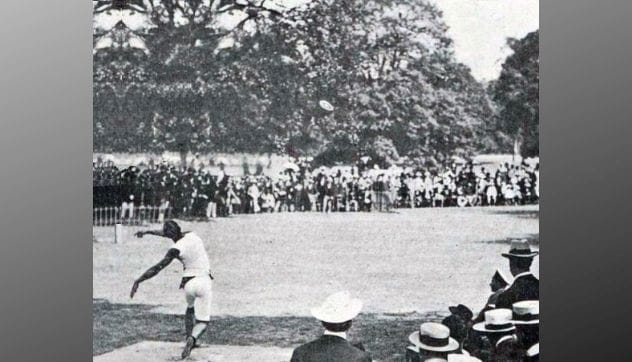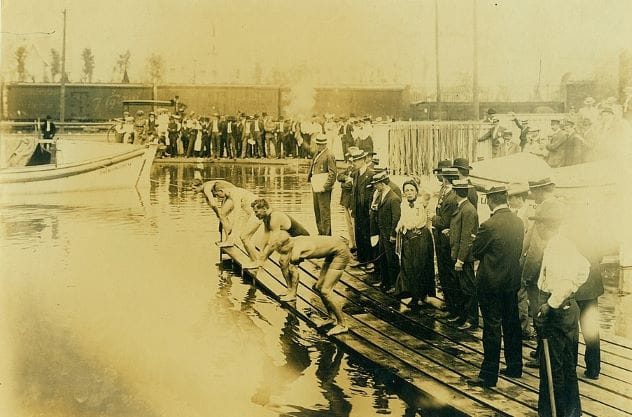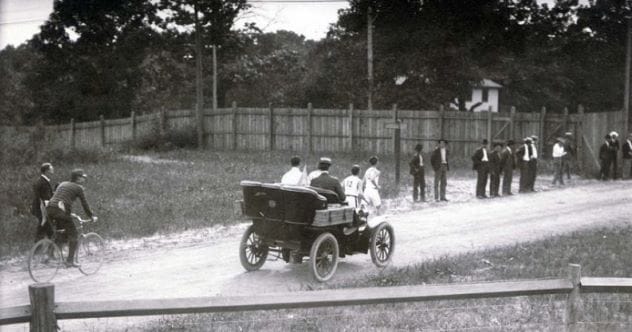When we think of the Olympics today, images of amazing, specially built stadiums and arenas come to mind. Host cities spend years planning and constructing these incredible places for athletes to shine. The goal is always to provide the best, safest environment for chasing Olympic gold.
But it wasn’t always like this. Since the modern Summer Games began in 1896, Olympic athletes have sometimes faced conditions that were more than just a little inconvenient. Some were downright dangerous! Get ready to discover ten times when Olympic venues were shockingly unsuitable for the world’s greatest athletes.
10. London, 1908: Rugby by the Pool
Picture this: it’s the Olympic rugby final in London. The British and Australian teams step onto the White City Stadium pitch. But wait, what’s that right next to the field? An open-air swimming pool! This wasn’t a water feature; it was a real hazard. Players could handle some damp grass, but a drop of several feet into a pool was a different story.
To try and prevent disaster, flimsy netting was stretched over the gap. Large mattresses were laid along the pool’s edge hoping to cushion any falls. The rugby ball often took a dive into the pool during the game. Reports said the Australians were better at handling the slippery, water-logged ball. They ended up winning 32-to-3. Luckily, while the ball got soaked, no players took an unplanned swim!
9. Tokyo, 1964: The Shallow Water Polo Pool
Water polo players arriving at the Tokyo Olympic pool in 1964 found a surprising problem: the water was too shallow. This immediately sparked complaints. Some teams argued that taller players could simply stand on the pool bottom, giving them an unfair advantage. The Hungarian coach even joked that his shortest player could touch the bottom.
One team, however, stayed quiet – Yugoslavia. They happened to be the tallest team in the tournament! Their players could easily stand and shoot. The hosts tried to raise the water levels, but the event went on. Perhaps there was some justice in the end. The Yugoslavians only won silver, while the Hungarians took home the gold.
8. Athens, 1896 & Antwerp, 1920: Freezing Swims
Olympic swimmers have often faced tough conditions, from wild waters to very basic pools. At the first modern Olympic Games in Athens, there wasn’t even an Olympic pool. Swimmers had to brave the icy waters of the Bay of Zea. Temperatures barely reached 13°C (55°F) on a chilly day. With all races on one day and few shelters, swimmers had little chance to warm up. Alfred Hajos, a Hungarian swimmer who won two events, said the cold was so bad his “will to live completely overcame his desire to win.”
Fast forward to the 1920 Antwerp Games. A new pool was built, and the IOC president praised it. But many athletes disagreed. American swimmer Aileen Riggin said her teammates hated it. She described it as looking like “a ditch that had just been dug.” Swimmers reported the water was black and freezing. They had to wear several layers of clothes just to stay warm after their races.
7. Paris, 1900: A Track and Field Mess

The 1900 Paris Games are often called one of the worst modern Olympics. They were tacked onto the city’s Universal Exposition World Fair almost as an afterthought. The organization was chaotic, and some venues were completely unfit for competition.
Track and field events were held in areas that looked more like parks for picnics. The public often wandered right through ongoing competitions! The running track was uneven, often wet, and had long grass in places. It wasn’t always marked properly. Hurdlers found themselves jumping over broken telegraph poles. Even stranger, the 400m hurdlers had to deal with a water jump in the final stretch. Thankfully, that didn’t become a standard feature.
The discus and hammer throwing events took place down a narrow lane lined with trees. If a throw hit a tree, it was a “no throw.” With hardly any safety rules, spectators had to be very careful to avoid flying objects.
6. St. Louis, 1904: The Deadly Pool

Just like Paris four years earlier, the St. Louis Summer Games were poorly organized and managed. They were also added to the city’s World Fair. For swimmers and water polo players, the facilities were especially terrible, with tragic results later on.
An artificial lake was created in the middle of the World Fair. It was meant for life-saving demonstrations but was also used for agricultural exhibits. Cattle grazed nearby and would wander into the water, contaminating it. This didn’t seem to worry the organizers much.
Swimming and water polo events were held in this dirty pool. Only three American teams entered the water polo event, eventually won by the New York Athletic Club. Even though they competed at the far end of the lake, the decision to play in such filthy water proved disastrous. Within a year, four of the water polo players died from typhus.
5. Berlin, 1936: Basketball in the Mud
Until the 1948 Games, Olympic basketball tournaments were held outdoors. This was fine if the weather cooperated. But then came Berlin in 1936. Matches were played on sandy tennis courts. On the day of the final, it rained. And rained. The court turned into a muddy mess, making it incredibly hard to score. When the ball hit the water-soaked ground, it just stopped. The lumpy, wet ball also made passing a nightmare.
The finalists, USA and Canada, both wanted to postpone the match. However, the German organizers insisted it go ahead as planned. Years later, a Canadian player recalled, “Michael Jordan could have slipped from foul line to foul line and scored a basket without taking any steps.” The USA eventually won the very low-scoring final, 19 to 8. Canadian player Jim Stewart managed to sneak the ball off the court as a souvenir. His teammates didn’t mind; it was like a soggy, muddy soccer ball, and nobody else wanted it.
4. London, 1948: Racing in the Dark
Known as the “Austerity Games,” war-torn London hosted the first Olympics in twelve years. The running track at Wembley’s Empire Stadium was only laid two weeks before the Games began. What organizers didn’t anticipate was the athletics program running very late into the day. This was a big problem because the stadium had no infield lighting.
On a damp Friday evening, the decathlon’s final day was supposed to finish at 6 pm. But delays meant darkness fell with three events still to go. The eventual winner, 17-year-old Bob Mathias from the USA, had already spent time searching on his hands and knees for a lost flag marker in the discus event. Just after 9 pm, he started the pole vault alone, as his rivals had finished. A teammate helped by pointing a flashlight up at the bar so Mathias could see. He made the winning height.
He then won the javelin, even though the no-throw foul line was invisible in the gloom. At 10:30 pm, the 1500 meters was run in pouring rain, with car headlights helping to light up parts of the track. Although he came third in that race, Mathias had overcome the darkness and all other obstacles to become an Olympic champion—the youngest ever to win decathlon gold.
3. St. Louis, 1904: The Grueling Marathon
Back in St. Louis, it wasn’t just the water sport athletes who faced terrible conditions. Poor organization turned the Games’ toughest event, the marathon, into something of a farce. Only pure luck prevented even more serious outcomes.
The marathon course was an unbelievably difficult endurance test, especially for many inexperienced runners. Starting in heat close to 35°C (95°F), the unpaved roads were covered in thick dust. Runners had to climb seven steep hills and run over rough, stony ground, all while dodging people and other obstacles on the road.
Several athletes collapsed after breathing in too much dust. One nearly died. To make things even worse, there were only two water stops along the entire route. The chaos continued right to the finish line. American Fred Lorz was declared the winner, but it turned out he’d hitched a ride in a car for ten miles of the race! His teammate, Tom Hicks, who was completely exhausted, was then awarded the win. Hicks only managed to finish with help and after being given a “medicinal” mix of brandy, eggs, and strychnine (a poison!) during the race. This tonic could have been fatal if doctors hadn’t helped him immediately after he crossed the line.
2. Beijing, 2008: The Smoggy Games
Even more recent Olympic Games haven’t been free from poor planning. The Beijing Games in 2008 presented a serious problem for all competitors: it was the most polluted Olympics in history. In the year before the Games, the International Olympic Committee was so worried that they considered postponing some endurance events.
As the Olympics started, evening rain showers and changes in wind direction helped to reduce the pollution slightly. However, at times, the sun could barely be seen through the smog. Competitors often struggled in the heat and humidity, and extra rest breaks were introduced. The football finals, for example, had stoppages after 30 minutes in each half. Athletes with asthma were particularly affected. Some medal contenders, like marathon world-record-holder Haile Gebrselassie and 2004 cycling silver medallist Sergio Paulinho, decided not to risk their health and pulled out due to respiratory concerns.
1. POW “Olympics,” 1944: Spirit Over Adversity
This one is a bit different, but it perfectly shows how the “Olympic spirit” can triumph over truly awful conditions. The POW “Olympic Games” of 1944 are a powerful example. World War II had caused the cancellation of the 1940 Tokyo and 1944 London Games. However, Polish prisoners of war in German-controlled camps were determined to hold their own Olympics. An earlier, similar event in 1940 had to be kept secret; discovery would have meant severe punishment for the POWs at Stalag XIII A in Nuremberg.
In 1944, however, guards at Woldenberg Camp gave permission for an “Olympics” to be held in the harsh camp environment, though with some restrictions. The Polish POWs enthusiastically made an Olympic flag from old bedsheets. They also created paper medals and special stamps. Many events were held, including track and field, basketball, football, handball, and volleyball. The boxing tournament was popular but had to be cut short due to injuries, as the prisoners were in a weakened physical state. Unsurprisingly, camp authorities didn’t allow events like pole vaulting, fencing, javelin, or archery. In total, 369 prisoners took part in 464 competitions, including some social and cultural events, which were common in the Games at that time.
These stories remind us that the path to Olympic glory hasn’t always been paved with perfect conditions. From makeshift tracks to hazardous waters, athletes of the past often showed incredible resilience and determination. Thankfully, modern Olympics prioritize athlete safety and top-notch facilities far more, but these tales are a fascinating glimpse into a wilder Olympic history.
Which of these Olympic venue stories surprised you the most? Share your thoughts in the comments below!










